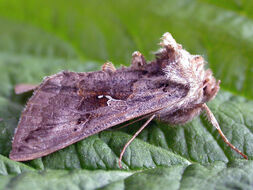
Silver Y - D Shenton
The Silver Y (Autographa gamma) is a migratory moth of the family Noctuidae which is named for the silvery Y-shaped mark on each of its forewings.
Description[]
The Silver Y is a medium-sized moth with a wingspan of 30 to 45 mm. The wings are intricately patterned with various shades of brown and grey providing excellent camouflage. In the centre of each forewing there is a silver-coloured mark shaped like a letter Y or a Greek letter Gamma. There are several different forms with varying colours depending on the climate in which the larvae grow.
Forms[]
There are many different forms of this species. The most common is grey, but some are brown, or purple tinged. If the moth is very pale, this is due to a hot climate (form pallida). There is also a small form (form gammina) which is probably due to little feeding as a larva. There is also a black form (form nigricans), though the Y mark is still prescent. There are two rare forms which affect the Y mark; Form gartneri has the Y mark greatly enlarged, and the form bipartita has the Y mark seperated, quite similar to that of the Ni Moth.
Distribution[]
The species is widespread across Europe, parts of Asia, and North Africa. It is resident in the south of its range and adults fly almost throughout the year. In spring variable numbers migrate north reaching as far as Iceland, Greenland, and Finland with huge invasions taking place in some years. A second wave of migrants arrives in the summer. In central Europe and the British Isles adults are present in significant numbers from May onwards with numbers dwindling in late autumn as they are killed off by frosts. Some individuals fly south again to winter around the Mediterranean and Black Seas.
It occurs in a wide variety of habitats, particularly open areas. It regularly visits gardens to take nectar from the flowers.
Life history[]
Silver Y moths can produce two or three generations in a year with a fourth generation when conditions are particularly good. The eggs are laid on the upper or lower surface of leaves. They are whitish in colour and hemispherical in shape with deep ribbing. They hatch after three to four days (longer in cool conditions).
The larvae are about 30 mm long, have three pairs of prolegs and are usually green with whitish markings. They feed on a wide variety of low-growing plants and have been recorded on over 200 different species including crops such as the garden pea (Pisum sativum), sugar beet (Beta vulgaris) and cabbage (Brassica oleracea). They can reduce crop yields by damaging leaves and are often considered to be a pest.

The Silver Y can be found at any time of the year, but is most active from May to September
The pupa is green at first, gradually darkening to black. The adults mate one or two days after emerging from the pupa and start laying eggs one to five days later. They die three to nineteen days after emergence.
Similar Species[]
There are several similar members of the Plusiinae subfamily, but no others have a Y mark. Ni Moth have their "ni" mark, which sometimes join, but is usually more ornate. The Scar Bank Gem is also more ornate than the Silver Y, and while usually the "Y" is seperated, they do join together. The Scarce Silver Y also has the Y seperated.
Gallery[]
Videos[]

00000







